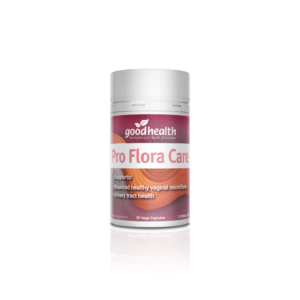
We have microbes in our mouth, gut, ears… basically, anywhere we possess a cavity. Not only that, but our skin is crawling with microscopic critters, and it may surprise you to know that they can be found nearly everywhere in the body. Some seem to be good, some potentially bad; most of the time they are supposed to get on with us and each other, but things can go awry, leading to increasing rates of microbial imbalance in modern humans. We might know more about the surface of Mars than our own microbiomes, but we know enough to realise how indispensable our personal microbial “fingerprint” is for our overall health and for the health of those things that are uniquely female.

The microbiome by the numbers
The past 15 years have seen an explosion in microbiome and probiotic research. In 2007 the United States National Institutes of Health launched the Human Microbiome Project, a major research initiative. The goal was to improve understanding of the human microbiota and its role in health and disease, to develop technologies capable of detailed investigations, to create resources and databases, and to map microbial genetics and characteristics. Even after this massive undertaking and thousands of recent private or publicly funded studies, we still know relatively little. We are only just beginning to get a handle on the mechanisms involved in microbial communication and function in certain disease states and whether there is a causal or incidental relationship. Many species simply have not been studied outside of the human body because they cannot be cultured (grown in a lab).
It is estimated that the human body can accommodate 30-50 trillion bacteria, depending on the size of the person, and most of them reside in the large bowel and in areas that are in contact with the outside, like the nose and mouth. Bacteria produce postbiotic products for their host, including short-chain fatty acids, bacteriocins, carbonic substances, some nutrients, and enzymes (although not all are always beneficial). Our immune function is particularly dependent on microbes giving cues to our immune cells, supporting their maturation, and the “priming” of our immune system. Other types of microbes, including fungi (mycobiome), archaea (archaeome), parasites (helminths), and viruses (virome), may also exist in the trillions, but we know much less of their activities. You may also have heard the term “microbiota”—this” refers to the genetic mix of all living organisms (bacteria, viruses, etc.) in a certain area, e.g., the gut, vagina, or mouth, whereas “microbiome” refers to the organisms, their products, and their structures and environment, and generally refers to the totality of the microbes in and on our body as a whole. The two terms are often used interchangeably. Our health is also influenced by the products and structures of microbial activity, so microbiome is the most common term.
It was thought that our microbes outnumber our cells by 10 to 1, but it may actually be closer to 2 or 3 to 1, with variability from human to human. Our mitochondria, the power-generating organelles in each of our cells (except red blood cells), are bacterial descendants that merged with other cells in a process called endosymbiosis. In fact, some scientists argue that each little mitochondrion is still a bacterium! We are symbiotically linked with all of the microscopic creatures on the planet, and when they are in harmony, we are in harmony. Our individual microbiomes are as unique to us as our fingerprints and are established within the first year or 2 of life. Having said that, the microbiome can make shifts in composition, according to age, environment, stress, and diet. We share microbiomes with the people in our lives, especially with those we are closest to.

What constitutes a healthy microbiome?
One of the first lines of defense in our body is a healthy microbiome is. Our digestive microbiome (mouth to anus) contains an extremely diverse range of microorganisms, and this diversity appears to be linked to our health. Because some very healthy, primitive-living humans, such as the Maasai, have relatively low gut microbial diversity more research is needed to find out whether diversity or simply a harmonious mix confers health. The female genitourinary system—vagina, uterus, fallopian tubes, ovaries, urethra, and bladder—houses a microbiome that appears to be healthier when it has low diversity. The microbiotic balance in this system can change with age and environment, and monthly hormonal shifts can affect microbial balance, although studies in healthy females find that those same types of dramatic shifts do not tend to happen when overall health is good. Microbiotic imbalances in the gut or genitourinary tract have been shown to adversely affect fertility and/or the ability to stay pregnant, and reproductive specific immune health. Maintaining a healthy, whole-body microbiome is now thought to be key to healthy lifelong physiological function.
One of the biggest challenges is determining what constitutes a “normal” or “healthy” microbiome. What is considered healthy in terms of bacterial composition may differ wildly throughout the world. For example, researchers have found bacteria in the guts of hunter/gatherer populations that would usually cause serious diseases in humans in the developed world, yet those “primitive” tribespeople do not succumb to those diseases. It appears that the overall balance of your microbes is more important than individual species being either beneficial or harmful. It may be that a healthy microbiome is one that you have when you are healthy!
What can upset the balance?
Antibiotic treatment can cause the decrease or extinction of certain species, leading to low-diversity or unbalanced microbiota. In this instance, potentially harmful bacteria can become dominant—a situation known as dysbiosis—and this has been linked to many conditions in the body. Studies have shown that pesticides like glyphosate can adversely affect key microbial species in the gut with knock-on effects throughout the body, particularly on reproductive hormones. Additionally, the consumption of refined sugar and sweeteners can upset the microbial balance in the mouth, gut, and urinary tract. Stress and lack of appropriate sunlight can also disrupt eubiosis (balanced microbiome), as can sexual activity, especially if hygiene practices are subpar.
Links between microbiomes and health
There is a well-researched link between altered gut microbiome and reproductive and genitourinary disorders in females. Studies on the gut microbiome-oestrogen axis have shown where progesterone and oestrogen levels in the body can be supported by the enzyme secretion and postbiotic production of gut microbes. Studies have also found that our microbiome health positively affects our bone health. There are probiotic strains that have been shown to directly support bone density—so important post menopause—and strains that positively or negatively support our metabolism—a huge contributor to reproductive health.

Gut microbial balance can directly and indirectly support the health of the urinary tract. We know that females are more prone to urinary and vaginal immune imbalances because of the relatively short distance between the anus and vagina, but there has also been research into how the balance of gut microbes can support the health and function of the vagina and urethra (urine-conducting tube). Many of us have experienced the awful effects of a vaginal yeast imbalance after taking antibiotics. Scientists have identified specific strains of oral probiotics that can support the vaginal microbial balance via the gut. Probiotics are live microbes that are considered beneficial to the body when consumed orally or applied topically.
Click here for more on the female hormonal cycle and here for tips on how to have healthy hormones (and microbiomes) throughout the female life stages.
Introducing: Good Health Pro Flora Care
Good Health Pro Flora Care is a scientifically studied formulation of 5 probiotic strains to support a healthy immune response in the female genito-urinary system. Many of the immune issues women face in their reproductive and urinary tracts stem from an unbalanced vaginal and urinary flora. An ecologically stable vaginal microbiome is generally identified by a high level of Lactobacillus species. Lactobacillus strains play an important role in the support of genital immune issues by supporting the vaginal pH and microbial balance via their postbiotic output. This makes supports an inhospitable environment for some harmful microorganisms, and beneficial microbes to outcompete other bacteria.
A colony-forming unit (CFU) estimates the number of viable microbial cells that are able to multiply and colonise the appropriate tissue. Pro Flora Care contains at least 12 billion total CFUs of highly researched Lactobacillus strains: L. rhamnosus GR-1 supports a balanced vaginal microbiota and gut lining integrity; reuteri RC-14 supports a healthy immune response and yeast/flora balance; gasseri LG-G12 supports vaginal pH and crowding out of harmful microbes; high-strength acidophilus LA-G80 supports female reproductive and digestive health, plus microbial balance in the vaginal and urinary tract; and crispatus LC-G22 supports a stable microflora. These 5 strains have been found to be specific to the female genito-urinary system, supporting the crowding out of “bad” microbes and a balanced microbiome.
Good Health Pro Flora Care is designed to support a healthy vaginal microflora and pH balance throughout the monthly cycle while also supporting reproductive, digestive, and overall health and wellbeing.

Pro Flora Care Supports:
- Balanced vaginal pH
- Healthy vaginal microflora and yeast balance
- Urinary tract health
- Beneficial microbial colonies
- The free flow of microbes
- Healthy fertility
- Reproductive, gut, and overall health
Click the following for more in the Women’s Health Series:
The 3 Ms and the Female Hormonal Life Cycle, Part 1 – Menarche
The 3 Ms and the Female Hormonal Life Cycle, Part 2 – Menstruation
The 3 Ms and the Female Hormonal Life Cycle, Part 3 – Menopause
Ancestral Wisdom for Female Hormonal Health Part 1
Ancestral Wisdom for Female Hormonal Health Part 2
TAPS No: PP2522
